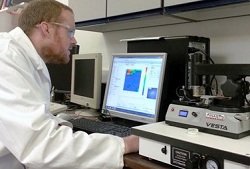AT THE University of East Anglia, UK , post-doctoral researcher Jonathan Moffat is studying the delivery of drugs with poor water solubility, and looking in particular at the characterisation of delivery systems.

Jonathan Moffat using the Anasys Nano-TA system at the University of East Anglia (UAE)
His team creates solid dispersions using a variety of methods, include hot melt extrusion, spray drying, and spin coating.
In solid dispersions, one or more components are molecularly dispersed in a matrix or carrier. If a drug can be dispersed in a water soluble matrix such as a polymer, the dissolution profile and bioavailability of the drug can be improved.
The standard characterisation methods for these systems include differential scanning calorimeter (DSC), Fourier transform infrared spectroscopy (FTIR), and powder X-ray diffraction (PXRD). The main drawback of these is that they provide only bulk information.
“We are analysing samples consisting of two or more components, so we are interested in looking at the distribution, form, and interface of components. The standard techniques cannot provide this information and, because the surface of these systems is extremely important as this is the interface between the delivery system and the body, we chose the Anasys Nano-TA system. This permits thorough surface characterisation, and is used alongside standard atomic force microscopy and scanning electron microscopy imaging”, observed Dr Moffat.
“While these methods give high resolution images of the sample surface, they don’t provide information on the components. Using Nano-TA along with AFM allows us to pick out features on the surface, interrogate them, and then determine the individual component via its transition temperature.
“It is also possible to determine morphological properties, as the transition temperature is sensitive to differences in these properties – something that can be difficult with spectroscopic techniques. We also use Transition Temperature Microscopy, TTM, for our samples. This gives a systematic approach to determine the distribution and form of the components and also provides information on how well mixed the systems and whether there is any phase separation.”
An example of this work was presented in a poster at the recent American Association of Pharmaceutical Scientsists (AAPS) meeting in Chicago, USA. A poster co-authored by Dr Moffat and Professor Duncan Craig (also from UEA), “Thermal Probe Methods for Nanoscale Characterization of Cyclosporin A Solid Dispersions Prepared by Hot Melt Extrusion” was presented at the meeting.
